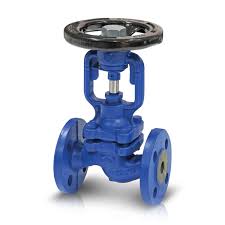Introduction to Bellow Sealed valves

Size: NPS 2″~30″(DN50~DN1650)
Pressure Rating: ASME CLASS 150~1500(PN16~PN260)
Body Material:Carbon steel, Stainless steel, Alloy steel, Low-temperature steel, Duplex stainless steel, Nickel base alloy steel
End Connection:RF, BW, RTJ
Operation:Manual, Pneumatic, Electric, Hydraulic
Bellow-Seal Valve Features:
- Each valve is tested per API 598.
- Every bellow assembly is helium leak-tested to assure zero leakage.
- Non-rotating stems prevent torsion of bellow.
- Secondary stem seals include:
- Stem backseat
- API 624 stem packing
- Lubricant fittings to ensure proper lubrication of stem bushing for efficient opening and closing.
- Multiple bellows materials are available: 316Ti, Hastelloy, Inconel, Monel, etc.
- All bellows are hydroformed with a minimum of two layers.
- Available in pressure classes 150-1500 (All body materials available)
Leakage from the valve gland or stuffing box is a common concern for maintenance or plant engineers. This leakage can lead to several issues:
- Loss of Material: The leakage results in the loss of valuable materials or products.
- Pollution to the Atmosphere: The leakage can contribute to environmental pollution.
- Danger for Plant Employees: The leakage can pose a safety hazard to plant personnel.
For example, in the case of steam leakage through the valve gland, a clearance of just 0.001″ at 150 PSI can result in a leak of 25 lb/hour, which equates to a loss of $1.2 per eight-hour shift or $1,100 per year. Similarly, a tiny drop of 0.4 mm diameter per second can lead to the waste of about 200 liters per year of costly oil or solvent.
Bellow Seal Valve Construction and Operation
To address these leakage concerns, the bellow seal valve is a popular solution. Let’s explore the construction and operation of this valve type.
Bellow Construction
The bellow cartridge is welded to both the valve bonnet and the valve stem. The bellow cartridge has a number of convolutions, which become compressed or expanded depending on the movement of the valve stem.
The bellow can be sealed to the valves in two different ways:
- Bellow Welded to Valve Stem and Body: In this case, the process fluid is contained inside the bellow.
- Bellow Welded to Valve Stem and Bonnet: In this case, the process fluid is contained in the annular region between the valve bonnet and bellow (from the outside).
Bellow Types
There are two main types of bellows: the Forged Bellow and the Welded Bellow. Forged bellows are made by rolling a flat sheet (thin wall foil) into a tube and then mechanically or hydrostatically forming it into a bellow. Welded leaf bellows are made by welding washer-like plates of thin metal together at both the inner and outer circumference.
Bellow Design
The multi-ply bellow design is preferred for handling higher pressure fluids, as it can increase the pressure rating by 80% to 100% compared to a single-ply bellow of the same thickness.
Bellow Materials
The most popular stainless steel bellow material is AISI 316Ti, which contains Titanium to withstand high temperatures. Inconel 600, Inconel 625, and Hastelloy C-276 are also used to improve fatigue strength and corrosion resistance.
Valve Options and Applications
The gate valve and globe valve are the most common valve types to be fitted with bellow seals due to their internal construction and axial movement of the valve stem.
Bellow seal valves are used in a variety of applications, including:
- Heat Transfer Media: To prevent the risk of fire due to hot oil spillage on highly flammable chemicals.
- Vacuum/Ultra-High Vacuum: To prevent external air from entering the pipeline through the stuffing box.
- Highly Hazardous Fluids: Such as chlorine, hydrogen, ammonia, and phosgene, where leakage through the gland must be eliminated.
- Nuclear Plants and Heavy Water Plants: Where radiation leakage must be prevented at all times.
- Costly Fluids: Where leaks need to be avoided due to the high cost of the fluid.
- Environmental Standards: To meet stringent emission and environmental regulations.
